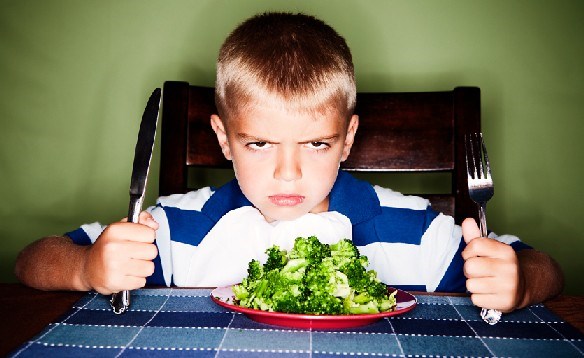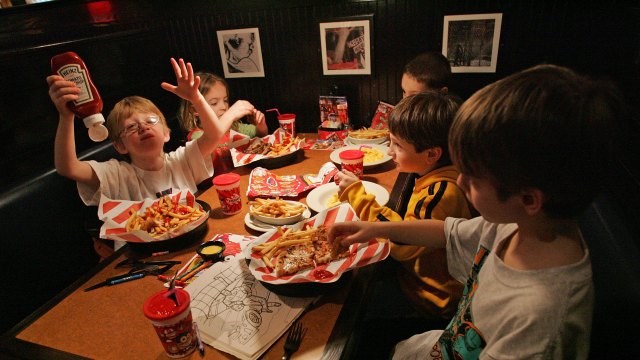 Just the thought of getting a cool cartoon replica or the latest action movie figure, even colored pencils or spinning tops brought about excitement and longing when we were children.
Just the thought of getting a cool cartoon replica or the latest action movie figure, even colored pencils or spinning tops brought about excitement and longing when we were children.
These coveted toys led us to ask even plead with our parents to buy us a kid's meal from our favorite fast-food restaurant.
In the late 1970s, McDonald's was the first fast food restaurant to create a meal for children that was linked to a toy. Their "Happy Meal" lived up to its name, and we pestered our parents to buy them.
More than 30 years later, fast food is coming under increased scrutiny, especially as it relates to children. Many fast-food chains now create healthier kids' meals including McDonald's. However some kid's meals can still be high in calories, sugar, fat and salt.
Even with this knowledge, many parents are still inclined to buy a kid's meal with an accompanying toy. But why? 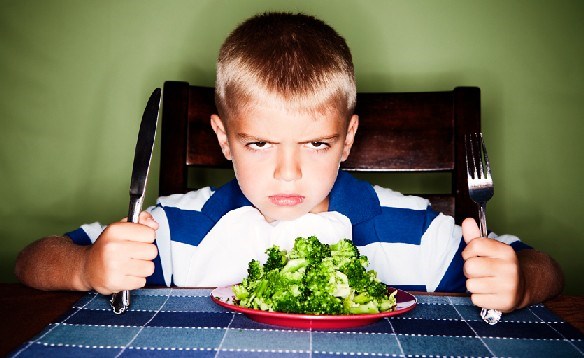
Well, the way in which food and beverages are marketed through promotion, advertising, and packaging has tremendous influence on our eating habits, especially our children's.
According to the Yale Rudd Center for Food Policy and Obesity, about 86% of the food marketed to children is unhealthy. There are several factors that increase the likelihood of exposure to unhealthy marketing.
Youth are exposed to marketing by spending, on average 7.5 hours per day online, watching TV, using mobile devices, listening to music, playing video games and reading print materials, according to report published by the Robert Wood Johnson Foundation.
Also, African-American children and teens see two times as many ads for sugary drinks as compared to other racial and ethnic groups of the same age; in part due to longer amounts in front of the TV than other children.
Proximity matters too. A study published in the Journal of Public Policy & Marketing last spring showed that the closer a fast food restaurant is to a school, the higher the students' levels of obesity. This significantly so for African-American and Latino students in low-income urban areas in which the association was four times stronger than for Whites and Asians.
Last year, in recognizing the health impact of ads and marketing on children, Disney become one of the first big corporations to announce a ban on junk food advertising on its radio, TV and online programming for children (starting in 2015).They will only allow for the marketing of products that align with the 2010 American Dietary Guidelines.
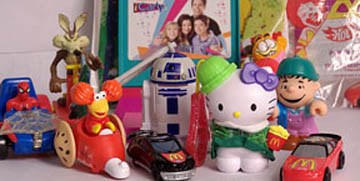
But what about the toy? The Federal Trade Commission estimates that in 2006, 10 fast-food restaurants spent over $360 million dollars in toy giveaways. In 2009 on average, children viewed 262 TV ads every week with toy promotions linked to fast food restaurants.
What does this create? Pester power — a young person asking, sometimes pleading, with their parent to buy the meal with a toy. It becomes an associative learning experience and this could potentially influence short and long term food choices of young people.
The good news... research is showing that marketing healthy food with a toy, especially a collectible, could be a successful way to promote eating more healthy foods. The question still remains if child will think the healthy food tastes just as good or better than the unhealthy food. Interestingly, research with adults shows that positive brand association overshadows what their brain says even if a product doesn't taste better.
Two counties in California have adopted policies that ban linking toys with high calorie meals but allow linking of toys and other incentives with healthier foods and beverages that meet certain nutrition criteria.
It is not easy to make healthy food choices when living in environments that are flooded with messages that encourage non-nutritious eating. Here are some suggestions to minimize the exposure of some of these messages to our children:
- Limit children's screen time, TV and Internet. The American Academy of Pediatrics says to discourage screen time for children less than two and to allow no more than 2 hours for older children. Children as young as two are heavily targeted. Compared to seven years ago, children see about 33% more ads now. They often learn about available toys at fast food restaurants through TV ads.
- DVR programs so that you can fast forward through the commercials.
- Have healthy fundraisers. Become an advocate in your child's schools or after-school program to limit bake sales and selling of unhealthy products.
- Join or engage with national groups that are working to limit unhealthy food marketing but who encourage healthy food marketing. Two such organizations are Momsrising.org and the Prevention Institute.
- Remember that we, as parents, family members, and caretakers for children, are primarily responsible for their health. We must make the rules — in home and at schools, not the advertisers. We must let children know what their limits and expectations are.
- Lead by example.
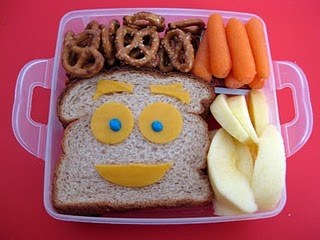
So maybe we do not have to take the "happy" out of the kid's meal. But let's all work together to put the 'healthy' into all kids' meals.

